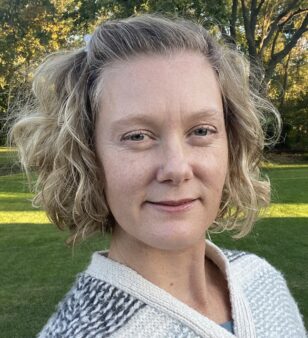
Sarah Carlson
- English
- French
Education
B.A., Connecticut College
M.F.A., University of Washington
Sarah Carlson is the Founder & Artistic Director of DanceLink, a project-based company which seeks to bridge people, ideas & understanding through the power of movement. Sarah danced professionally for 10 years in NYC with numerous companies including Alexandra Beller/Dances, Brian Brooks Moving Company, Clare Byrne Dance, Paul Mosley Dance and the Metropolitan Opera Ballet.
As an independent choreographer, her own work has been presented throughout the US at venues such as ArtsQuest SteelStacks, Gibney Dance in NYC, On the Boards in Seattle, and The Yard on Martha’s Vineyard as well as in Benin, Africa. Sarah is a co-director of the Lehigh Valley Dance Exchange & a licensed massage therapist. Sarah is currently an Associate Professor of Dance at Cedar Crest College and has been on the dance faculty at Lehigh University, Muhlenberg College, DeSales University, and the University of Southern Mississippi. In 2007, she completed a Fulbright Grant studying Vodou ritual dance in Benin, Africa furthering an on-going inquiry into sacred dance forms. Sarah is the proud recipient of the 2023 LVAIC Dance Consortium’s Dance Service Award. In 2008, Sarah founded DanceLink to promote community and to use the wisdom of the body to unpack the big questions, often spiritual in nature. DanceLink’s projects have received funding from the Pennsylvania Partners for the Arts, the Cultural Coalition of Allentown, the Lehigh Valley Dance Exchange, the Lehigh Valley Engaged Humanities Consortium and the King County Arts Commission. Sarah received a BA in French and European Studies from Connecticut College and an MFA in Dance from the University of Washington.
Philosophy of Teaching
Dance is not simply going through the motions, performing a sequence of movements set to music or in silence. Dance is self-expression that defies the boundaries of words and linear thought. It is image and feeling and emotion and truth. For years, I waited for a teacher to tell me that I was good enough, that I was talented enough to truly consider myself a dancer. But really, dance is not about technique and standards. It’s about channeling honesty through movement and having the courage to commit to that movement, to own it. That is what I long to communicate and pass along to every student.
The road to artistic ownership and maturity is different for everyone. By exploring various avenues of engagement, I hope to ignite inquiry and inspire students who are self-challenging, curious and highly motivated. Connecting dance to the larger scope of world history and culture will help students discover their place in the progression of dance and enliven their artistry with increased awareness of aesthetic form and context.
My pedagogical approach to dance technique class emphasizes sound kinesiological values and an understanding of efficient movement through physical exploration and awareness. Rather than stressing conformity to an aesthetic standard of perfection, I encourage dancers to fulfill the movement authentically by building strength, working on individual alignment and technique, and projecting their own kinesthetic voice throughout the dance.
Artistic Statement
Dance is a form of expression that transcends the boundaries of verbal language. Whether accompanied by text or on its own, bodily movement contains a visceral poignancy that triggers our kinesthetic, intellectual and emotional selves. In my choreography, I strive to create content and structures that at once communicate my vision and are widely meaningful. I enjoy the challenge of making visually interesting, multi-faceted, eminently accessible work. Tapping into the drama of theatrical performance, my dances juxtapose modern symbolism with overarching human truths. Key to my success is engaging the individual talents and humanity of my dancers. Whether working with experienced dancers or novice movers, I strive to use the wisdom of their bodies to unpack the big questions, often spiritual in nature. In this way, I hope to build dancers who are passionate about their performance and audiences who are captivated by their efforts.